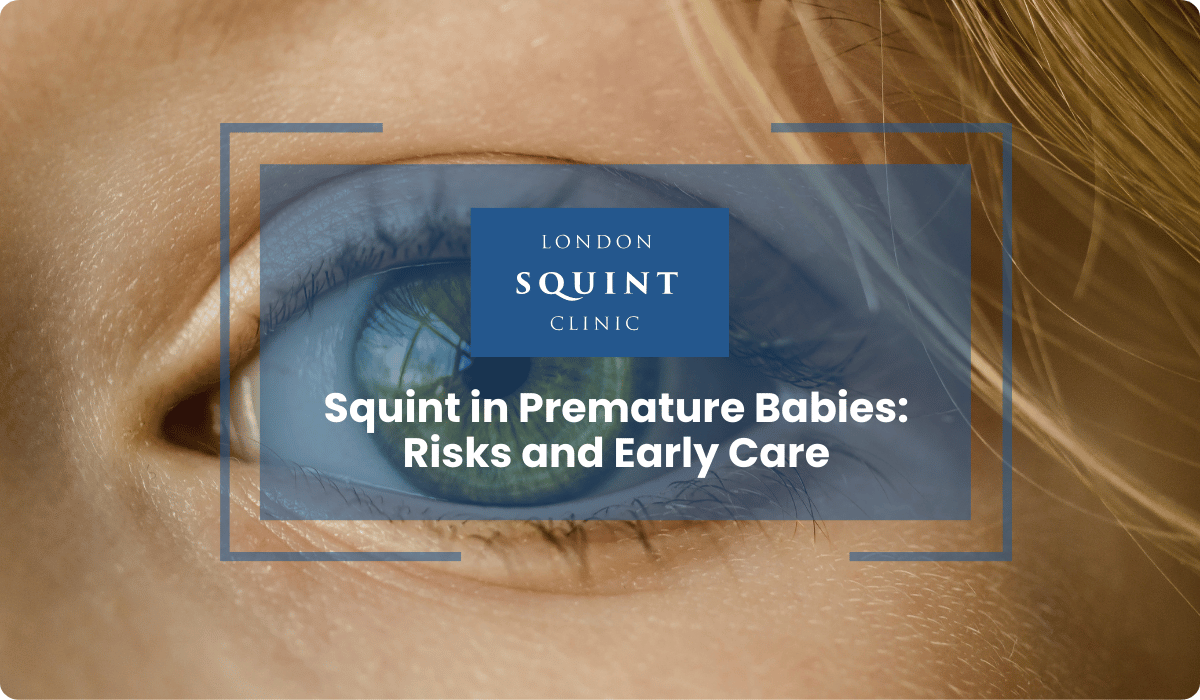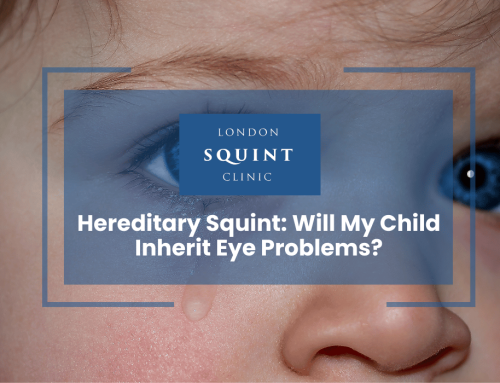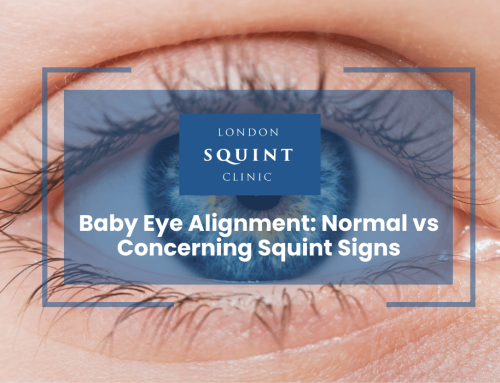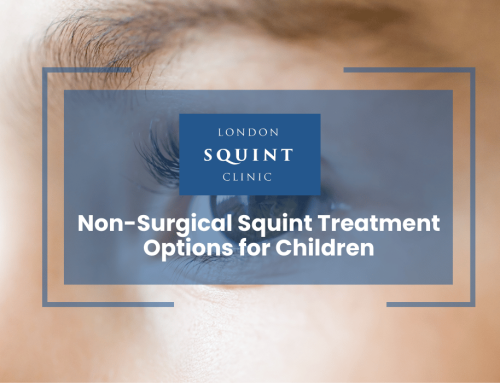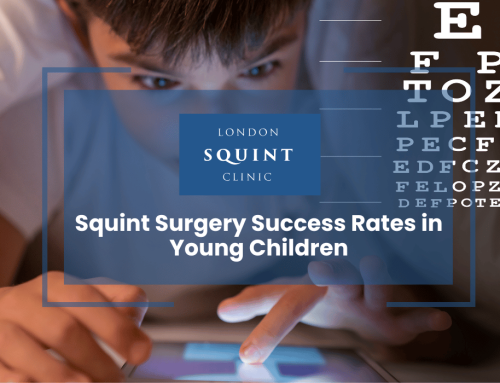Squint in Premature Babies: Risks and Early Care
Essential Insights for Parents of Premature Babies with Eye Concerns
Higher Risk Profile: Premature infants have a 20% chance of developing squint compared to 2-4% in full-term babies, with risk increasing with earlier gestational age.
Developmental Timeline: Always assess visual milestones using corrected age (chronological age minus weeks premature) rather than actual birth date.
Warning Signs: Persistent eye misalignment after 4 months corrected age, abnormal head positioning, poor visual tracking, and asymmetrical light reflexes in photographs warrant professional evaluation.
Treatment Options: Early intervention through prescription glasses, patching therapy, orthoptic exercises, and in some cases surgical correction can significantly improve outcomes.
Ongoing Monitoring: Visual development continues until 8-10 years of age, requiring regular ophthalmological follow-up even when no immediate concerns are apparent.
Table of Contents
- Understanding Squint in Premature Infants: Causes and Risk Factors
- Why Are Premature Babies More Vulnerable to Eye Alignment Issues?
- Recognizing Early Signs of Strabismus in Preterm Babies
- NICU Eye Screening: Essential Protocols for Premature Infants
- Treatment Options for Squint in Premature and Low Birth Weight Babies
- Long-term Visual Development: Monitoring Your Preemie’s Eye Health
- When to Seek Specialist Care for Your Premature Baby’s Eyes
Understanding Squint in Premature Infants: Causes and Risk Factors
Squint (strabismus) occurs more frequently in premature babies than in full-term infants, presenting a significant concern for parents and healthcare providers alike. This condition, characterised by misalignment of the eyes, affects approximately 20% of premature infants compared to 2-4% of the general paediatric population. The earlier the gestational age at birth, the higher the risk of developing ocular misalignment.
Several factors contribute to the increased prevalence of squint in premature babies. Neurological immaturity plays a crucial role, as the brain centres responsible for coordinating eye movements haven’t fully developed. Additionally, premature infants often experience disrupted visual development during critical periods when binocular vision is being established. The delicate process of neural pathway formation between the eyes and brain can be compromised when a baby is born before these connections are properly formed.
Retinopathy of prematurity (ROP), a condition affecting blood vessel growth in the retina, is strongly associated with subsequent strabismus development. Even when successfully treated, ROP can alter the structural development of the eye, potentially leading to squint. Other risk factors include intraventricular haemorrhage, periventricular leukomalacia, and prolonged oxygen therapy—all common complications in premature births that can impact visual pathway development.
Understanding these underlying causes is essential for early identification and intervention, which can significantly improve visual outcomes for premature infants with squint.
Why Are Premature Babies More Vulnerable to Eye Alignment Issues?
Premature babies face unique vulnerabilities that predispose them to eye alignment issues. The final trimester of pregnancy represents a critical period for ocular development, during which significant maturation of the visual system occurs. When babies are born prematurely, this development must continue outside the womb in an environment that differs substantially from the optimal conditions in utero.
The immature visual cortex in premature infants hasn’t yet developed the neural connections necessary for coordinated eye movements. This neurological immaturity affects the complex system that controls binocular vision and eye alignment. Additionally, premature babies often experience extended periods in neonatal intensive care units (NICUs), where they may be exposed to bright lights and undergo numerous medical interventions that can impact visual development.
Low birth weight, particularly very low birth weight (less than 1,500 grams), correlates strongly with increased risk of strabismus. These infants often have underdeveloped extraocular muscles, which are responsible for precise eye movements. The combination of muscle weakness and neurological immaturity creates a perfect storm for eye alignment difficulties.
Refractive errors, particularly high myopia (nearsightedness) and astigmatism, occur more frequently in premature infants and can contribute to squint development. These refractive issues may result from altered eye growth patterns and corneal development when birth occurs before these structures have fully matured.
The complex interplay between these factors explains why premature babies require vigilant monitoring of their visual development from the earliest stages, with particular attention to eye alignment and coordination.
Recognizing Early Signs of Strabismus in Preterm Babies
Identifying squint in premature infants requires careful observation, as the signs can be subtle and easily overlooked. Parents and healthcare providers should be vigilant for several key indicators that may suggest the presence of strabismus in preterm babies.
One of the earliest observable signs is persistent eye misalignment after 4 months of corrected age. While occasional misalignment is normal in newborns as they develop ocular control, consistent turning of one eye inward (esotropia) or outward (exotropia) beyond this period warrants professional evaluation. It’s important to note that assessment should be based on corrected age—calculated from the expected due date rather than the actual birth date—to account for prematurity.
Abnormal head positioning may indicate that a baby is compensating for visual difficulties. If your premature infant consistently tilts or turns their head to look at objects, this could suggest they’re attempting to align their vision. Similarly, frequent eye rubbing, squinting, or closing one eye when focusing on objects may indicate visual discomfort associated with strabismus.
Poor visual tracking is another potential indicator. Premature babies with developing squint may struggle to follow moving objects smoothly with both eyes. Parents might notice that their baby seems to lose interest in visually engaging toys or faces, which could reflect difficulty with visual focus and coordination.
Asymmetrical light reflexes in photographs can provide valuable clues. The “red-eye” effect from flash photography should appear symmetrically in both eyes; if one eye shows a different reflection pattern, this could indicate misalignment. This phenomenon, known as the Brückner test when performed clinically, can help detect subtle forms of strabismus before they become obvious.
Early recognition of these signs enables timely intervention, which is crucial for preventing long-term visual impairments such as amblyopia in premature babies.
NICU Eye Screening: Essential Protocols for Premature Infants
Comprehensive eye screening in the Neonatal Intensive Care Unit (NICU) forms a critical component of care for premature infants. These screenings follow established protocols designed to detect early signs of ocular complications, including those that may lead to strabismus. The British Association of Perinatal Medicine and the Royal College of Ophthalmologists have developed guidelines that recommend specific screening timelines based on gestational age and birth weight.
For infants born before 32 weeks’ gestation or weighing less than 1,500 grams, initial eye examinations typically begin at 4-6 weeks of chronological age or 31-33 weeks post-conceptional age, whichever comes later. These examinations focus primarily on detecting retinopathy of prematurity (ROP), but also assess overall ocular health and development, including eye alignment and movement patterns that might indicate early strabismus.
The screening process involves dilating the infant’s pupils with eye drops to allow clear visualisation of the retina and other internal structures. An ophthalmologist with expertise in neonatal eye care uses specialised equipment, including an indirect ophthalmoscope, to examine the eyes thoroughly. During this examination, the specialist also assesses pupillary responses, eye movements, and alignment—all potential indicators of developing strabismus.
Follow-up examinations are scheduled according to findings, with higher-risk infants requiring more frequent assessments. The frequency may range from weekly to monthly until the risk of ROP has passed, typically around 45 weeks post-conceptional age. Even after discharge from the NICU, premature infants should continue to receive regular ophthalmological follow-up to monitor for late-onset complications, including squint.
These structured screening protocols ensure that vision-threatening conditions are identified promptly, allowing for timely intervention and optimising visual outcomes for this vulnerable population.
Treatment Options for Squint in Premature and Low Birth Weight Babies
Treatment approaches for squint in premature infants are tailored to the specific type of strabismus, its underlying causes, and the baby’s overall development. Early intervention is paramount, as the visual system remains highly plastic during the first years of life, offering the greatest opportunity for successful correction and prevention of amblyopia (lazy eye).
For refractive errors contributing to accommodative squint, prescription glasses represent the first-line treatment. Many premature infants develop hyperopia (long-sightedness) or astigmatism that can lead to eye misalignment when they attempt to focus. Specially designed frames for infants ensure comfort and proper fit, with flexible materials and secure straps to keep glasses in place. Parents often report remarkable improvement in eye alignment once appropriate correction is provided.
Patching therapy may be recommended if amblyopia has developed alongside the squint. This involves covering the stronger eye for prescribed periods to encourage use of the weaker eye. For premature babies, patching regimens are carefully calibrated based on corrected age and the severity of amblyopia, with frequent reassessment to adjust treatment intensity.
Orthoptic exercises can help strengthen eye muscles and improve coordination in milder cases of strabismus. These exercises are typically introduced as the child develops better attention and cooperation skills, usually after 2-3 years of age. For premature infants with convergence insufficiency (difficulty maintaining proper eye alignment for near vision), specific convergence exercises may be beneficial as they grow older.
Surgical intervention becomes necessary when significant misalignment persists despite conservative measures. The timing of surgery for premature infants requires careful consideration, balancing the need for early alignment against the child’s ability to tolerate anaesthesia safely. Typically, surgery involves adjusting the tension of the extraocular muscles to restore proper alignment. For premature babies with complex medical histories, surgical planning includes comprehensive pre-operative assessment and coordination with paediatric anaesthetists experienced in managing former preemies.
Botulinum toxin (Botox) injections offer an alternative or adjunct to traditional surgery in select cases. This temporary treatment can be particularly useful in infants with acquired esotropia (inward turning) and may help determine the potential benefit of surgical intervention before committing to a permanent procedure.
Long-term Visual Development: Monitoring Your Preemie’s Eye Health
The visual development journey for premature infants extends well beyond the neonatal period, requiring vigilant monitoring throughout childhood. Understanding the timeline of normal visual milestones—adjusted for prematurity—helps parents and healthcare providers identify potential concerns promptly.
During the first year, premature babies should progress through several visual development stages, including sustained eye contact, visual tracking of objects, and developing hand-eye coordination. These milestones should be assessed based on corrected age rather than chronological age. For example, a baby born two months early would be expected to reach visual milestones at their corrected age (chronological age minus the number of weeks premature).
Regular ophthalmological follow-up appointments are essential, even when no immediate concerns are apparent. The recommended schedule typically includes assessments at 3, 6, and 12 months corrected age, then annually thereafter until school age. These examinations evaluate ocular alignment, refractive status, and visual acuity using age-appropriate testing methods. For premature infants with a history of retinopathy of prematurity or other neonatal eye complications, more frequent monitoring may be necessary.
Parents play a crucial role in ongoing visual monitoring. Maintaining a developmental diary that tracks visual behaviours can provide valuable information for healthcare providers. Note when your child begins to make eye contact, follow moving objects, reach for toys, and demonstrate visual recognition of familiar faces. Any regression in these abilities or asymmetry in visual behaviours warrants prompt professional evaluation.
As premature children reach school age, comprehensive vision assessments become increasingly important. Visual processing difficulties and subtle binocular vision problems may become apparent only when academic demands increase. These issues can affect reading fluency, attention span, and overall learning performance. Early identification of such challenges allows for appropriate interventions, including vision therapy, classroom accommodations, or specialised learning strategies.
Remember that visual development continues throughout childhood, with the visual system not fully mature until approximately 8-10 years of age. This extended developmental window provides opportunities for intervention but also necessitates ongoing vigilance for emerging visual issues.
When to Seek Specialist Care for Your Premature Baby’s Eyes
Knowing when to consult a specialist about your premature baby’s eye health can significantly impact long-term visual outcomes. While routine follow-up appointments are essential, certain situations warrant immediate attention from a paediatric ophthalmologist with expertise in premature infant care.
Seek specialist evaluation if you notice persistent eye misalignment after 4 months corrected age. While occasional crossing or wandering of the eyes is normal in newborns as they develop ocular control, consistent misalignment beyond this period requires professional assessment. This is particularly important for premature babies, who have higher baseline risk for strabismus.
Abnormal eye movements, such as rapid, involuntary oscillations (nystagmus) or unusual patterns of eye movement when tracking objects, should prompt immediate consultation. These may indicate neurological issues affecting vision that require specialised intervention. Similarly, if your baby consistently tilts or turns their head to look at objects, this compensatory behaviour might suggest ocular misalignment that needs evaluation.
Visual inattention or lack of visual engagement with surroundings by 3 months corrected age warrants specialist assessment. By this age, premature infants should show interest in faces and bright objects, follow moving targets briefly, and begin developing visual recognition. Absence of these behaviours could indicate visual impairment requiring intervention.
Any changes in the appearance of the eyes themselves—including cloudiness of the cornea or lens, white reflections in the pupil (leukocoria), or asymmetry in pupil size—necessitate urgent ophthalmological evaluation. These signs could indicate serious conditions requiring immediate treatment.
For premature infants with a history of retinopathy of prematurity (ROP), even if previously resolved, any new visual symptoms should trigger prompt reassessment. Late complications can develop months or years after initial ROP treatment, including retinal detachment, which requires emergency intervention.
When seeking specialist care, prioritise paediatric ophthalmologists with specific expertise in premature infant eye conditions. These specialists understand the unique challenges of examining very young children and interpreting findings in the context of prematurity. They can provide comprehensive assessment using techniques adapted for infants, including specialised equipment for examining small eyes and behavioural methods for evaluating visual function in pre-verbal children.
Frequently Asked Questions
How common is squint in premature babies?
Squint (strabismus) affects approximately 20% of premature infants compared to only 2-4% of full-term babies. The risk increases significantly with earlier gestational age at birth and lower birth weight. Babies born before 32 weeks or weighing less than 1,500 grams have the highest incidence of eye alignment issues.
At what age should a premature baby’s squint be treated?
Treatment for squint in premature babies should begin as soon as the condition is diagnosed and stable, typically using corrected age as a guide. Non-surgical interventions like glasses may start around 6 months corrected age. If surgery is required, it’s usually considered between 6-18 months corrected age, depending on the type and severity of the squint and the child’s overall health status.
Can a premature baby’s squint correct itself naturally?
Some forms of intermittent squint in premature babies may improve naturally as visual development progresses, particularly before 4 months corrected age. However, persistent squint after this period rarely resolves without intervention. Early evaluation by a pediatric ophthalmologist is essential to determine whether the condition requires treatment or might resolve spontaneously.
What is the link between retinopathy of prematurity (ROP) and squint?
Retinopathy of prematurity significantly increases the risk of developing strabismus, with studies showing that premature infants with a history of ROP are 3-4 times more likely to develop squint than those without ROP. This occurs because ROP can alter normal retinal development and affect the visual pathways that control eye alignment, even after successful ROP treatment.
How do glasses help with squint in premature babies?
Glasses help correct refractive errors (like long-sightedness or astigmatism) that often contribute to accommodative squint in premature infants. By providing proper focus without excessive eye strain, glasses reduce the need for the eyes to over-accommodate, which can trigger misalignment. For many premature babies with accommodative squint, appropriate glasses can significantly improve or completely resolve eye alignment issues.
What long-term vision problems can develop if a premature baby’s squint is left untreated?
Untreated squint in premature babies can lead to amblyopia (lazy eye), loss of depth perception (stereopsis), abnormal head postures, and permanent visual impairment. These complications occur because the brain begins to suppress vision from the misaligned eye during critical developmental periods. Early intervention is crucial to prevent these long-term visual deficits, which can affect academic performance and coordination skills later in life.
Find out if you are suitable for Double Vision Treatment
Not everyone is eligible for double vision surgery.
Find out if you could benefit from this life-changing surgery by taking the quick self-suitability quiz below:
Our most popular procedures

Hello, I’m Nadeem Ali
I’m one of the few eye surgeons in the world with 100% focus on Squint and Double Vision Surgery.
I have 24 years of eye surgery experience, and worked for 13 years as a Consultant at London’s renowned Moorfields Eye Hospital.
In 2023, I left the NHS to focus fully on treating patients from across the world at the London Squint Clinic. You can read more about me here.
There’s lots of information on the website about: squint surgery, double vision surgery and our pricing.
The most rewarding part of my job is hearing patients tell me how squint or double vision surgery has changed their lives. You can hear these stories here.
Mr Nadeem Ali
MA MB BChir MRCOphth FRCSEd(Ophth)
